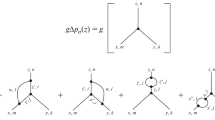Abstract
We consider massless elementary particles in a quantum theory based on a Galois field (GFQT). We previously showed that the theory has a new symmetry between particles and antiparticles, which has no analogue in the standard approach. We now prove that the symmetry is compatible with all operators describing massless particles. Consequently, massless elementary particles can have only half-integer spin (in conventional units), and the existence of massless neutral elementary particles is incompatible with the spin–statistics theorem. In particular, this implies that the photon and the graviton in the GFQT can only be composite particles.
Similar content being viewed by others
REFERENCES
E. P. Wigner, Ann. Math., 40, 149 (1939).
P. A. M. Dirac, “Theory of electrons and positrons,” in: The World Treasury of Physics, Astronomy, and Mathematics (T. Ferris, ed.), Little Brown, Boston (1991), p. 80.
F. M. Lev, Sov. J. Nucl. Phys., 48, 575 (1988); J. Math. Phys., 30, 1985 (1989); 34, 490 (1993).
F. M. Lev, “Problem of constructing discrete and finite quantum theory,” hep-th/0206078 (2002).
B. L. Van der Waerden, Algebra I, Springer, Berlin (1967); K. Ireland and M. Rosen, A Classical Introduction to Modern Number Theory, Springer, New York (1987); H. Davenport, The Higher Arithmetic, Cambridge Univ. Press, Cambridge (1999).
E. M. Friedlander and B. J. Parshall, Bull. Am. Math. Soc., 17, 129 (1987).
C. Fronsdal, Rev. Modern Phys., 37, 221 (1965).
N. T. Evans, J. Math. Phys., 8, 170 (1967).
B. Braden, Bull. Am. Math. Soc., 73, 482 (1967).
H. Zassenhaus, Proc. Glasgow Math. Assoc., 2, 1 (1954).
E. Inonu and E. P. Wigner, Nuovo Cimento, 9, 705 (1952).
Yu. V. Novozhilov, An Introduction to Elementary Particle Theory [in Russian], Nauka, Moscow (1972).
S. Weinberg, Quantum Theory of Fields, Cambridge Univ. Press, Cambridge (1995).
W. Pauli, Phys. Rev., 58, 116 (1940).
W. Pauli, “Exclusion principle, Lorentz group, and reflection of space–time and charge,” in: Niels Bohr and the Development of Physics (W. Pauli, ed.), Pergamon, London (1955), p. 30; G. Gravert, G. Luders, and G. Rollnik, Fortschr. Phys., 7, 291 (1959).
M. Flato and C. Fronsdal, Lett. Math. Phys., 2, 421 (1978); L. Castell and W. Heidenreich, Phys. Rev. D, 24, 371 (1981); C. Fronsdal, Phys. Rev. D, 26, 1988 (1982).
P. A. M. Dirac, J. Math. Phys., 4, 901 (1963).
E. P. Wigner, “The unreasonable effectiveness of mathematics in natural sciences,” in: The World Treasury of Physics, Astronomy, and Mathematics (T. Ferris, ed.), Little Brown, Boston (1991), p. 526.
Rights and permissions
About this article
Cite this article
Lev, F.M. Massless Elementary Particles in a Quantum Theory over a Galois Field. Theoretical and Mathematical Physics 138, 208–225 (2004). https://doi.org/10.1023/B:TAMP.0000014852.33122.50
Issue Date:
DOI: https://doi.org/10.1023/B:TAMP.0000014852.33122.50



